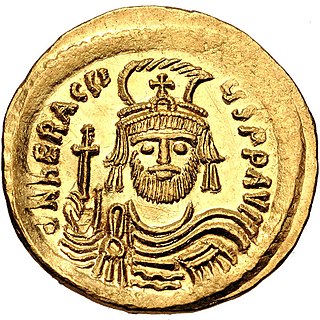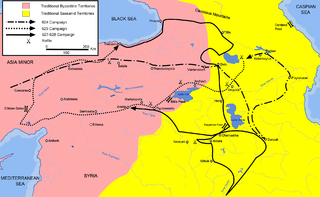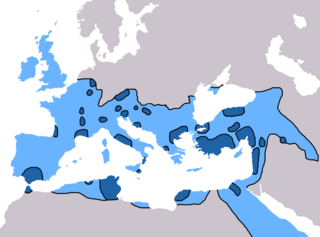
Heraclius was Byzantine emperor from 610 to 641. His rise to power began in 608, when he and his father, Heraclius the Elder, the exarch of Africa, led a revolt against the unpopular usurper Phocas.
The 620s decade ran from January 1, 620, to December 31, 629.
The 610s decade ran from January 1, 610, to December 31, 619.
The 630s decade ran from January 1, 630, to December 31, 639.
The 650s decade ran from January 1, 650, to December 31, 659.

Year 634 (DCXXXIV) was a common year starting on Saturday of the Julian calendar. The denomination 634 for this year has been used since the early medieval period, when the Anno Domini calendar era became the prevalent method in Europe for naming years.

Year 624 (DCXXIV) was a leap year starting on Sunday of the Julian calendar. The denomination 624 for this year has been used since the early medieval period, when the Anno Domini calendar era became the prevalent method in Europe for naming years.

Year 625 (DCXXV) was a common year starting on Tuesday of the Julian calendar. The denomination 625 for this year has been used since the early medieval period, when the Anno Domini calendar era became the prevalent method in Europe for naming years.

Year 626 (DCXXVI) was a common year starting on Wednesday of the Julian calendar. The denomination 626 for this year has been used since the early medieval period, when the Anno Domini calendar era became the prevalent method in Europe for naming years.

Year 613 (DCXIII) was a common year starting on Monday of the Julian calendar. The denomination 613 for this year has been used since the early medieval period, when the Anno Domini calendar era became the prevalent method in Europe for naming years.

The Battle of Nineveh was the climactic battle of the Byzantine–Sasanian War of 602–628.
Rhahzadh, originally Roch Vehan, known in Byzantine sources as Rhazates was a Sasanian general of Armenian origin under Shah Khosrow II.
Ricberht, may have briefly ruled East Anglia, a small independent Anglo-Saxon kingdom which today forms the English counties of Norfolk and Suffolk. Little is known of his life or his reign.

The Byzantine Empire was ruled by emperors of the dynasty of Heraclius between 610 and 711. The Heraclians presided over a period of cataclysmic events that were a watershed in the history of the Empire and the world. Heraclius, the founder of his dynasty, was of Armenian and Cappadocian (Greek) origin. At the beginning of the dynasty, the Empire's culture was still essentially Ancient Roman, dominating the Mediterranean and harbouring a prosperous Late Antique urban civilization. This world was shattered by successive invasions, which resulted in extensive territorial losses, financial collapse and plagues that depopulated the cities, while religious controversies and rebellions further weakened the Empire.

The siege of Constantinople in 626 by the Sassanid Persians and Avars, aided by large numbers of allied Slavs and Bulgars ended in a strategic victory for the Byzantines. The failure of the siege saved the empire from collapse, and, combined with other victories achieved by Emperor Heraclius the previous year and in 627, enabled Byzantium to regain its territories and end the destructive Roman–Persian Wars by enforcing a treaty with borders status quo c. 590.

The Western (Latin) and Eastern (Greek) divisions of Christianity began to take on distinctive shape in 7th-century Christianity. Whereas in the East the Church maintained its structure and character and evolved more slowly, in the West the Bishops of Rome were forced to adapt more quickly and flexibly to drastically changing circumstances. In particular, whereas the bishops of the East maintained clear allegiance to the Eastern Roman emperor, the Bishop of Rome, while maintaining nominal allegiance to the Eastern emperor, was forced to negotiate delicate balances with the "barbarian rulers" of the former Western provinces. Although the greater number of Christians remained in the East, the developments in the West would set the stage for major developments in the Christian world during the later Middle Ages.

The Byzantine–Sasanian War of 602–628 was the final and most devastating of the series of wars fought between the Byzantine / Roman Empire and the Sasanian Empire of Iran. The previous war between the two powers had ended in 591 after Emperor Maurice helped the Sasanian king Khosrow II regain his throne. In 602 Maurice was murdered by his political rival Phocas. Khosrow declared war, ostensibly to avenge the death of the deposed emperor Maurice. This became a decades-long conflict, the longest war in the series, and was fought throughout the Middle East: in Egypt, the Levant, Mesopotamia, the Caucasus, Anatolia, Armenia, the Aegean Sea and before the walls of Constantinople itself.
Shahraplakan, rendered Sarablangas (Σαραβλαγγᾶς) in Greek sources, was a Sassanid Persian general (spahbed) who participated in the Byzantine–Sasanian War of 602–628 and the Third Perso-Turkic War.
The 600s decade ran from January 1, 600, to December 31, 609.
The Siege of Tbilisi (627-628) was a siege by the Byzantine Empire and Western Turkic Khaganate in 627-628 against Prince Stephen I of Iberia, the Sasanid vassal ruler of Sasanian Iberia.











